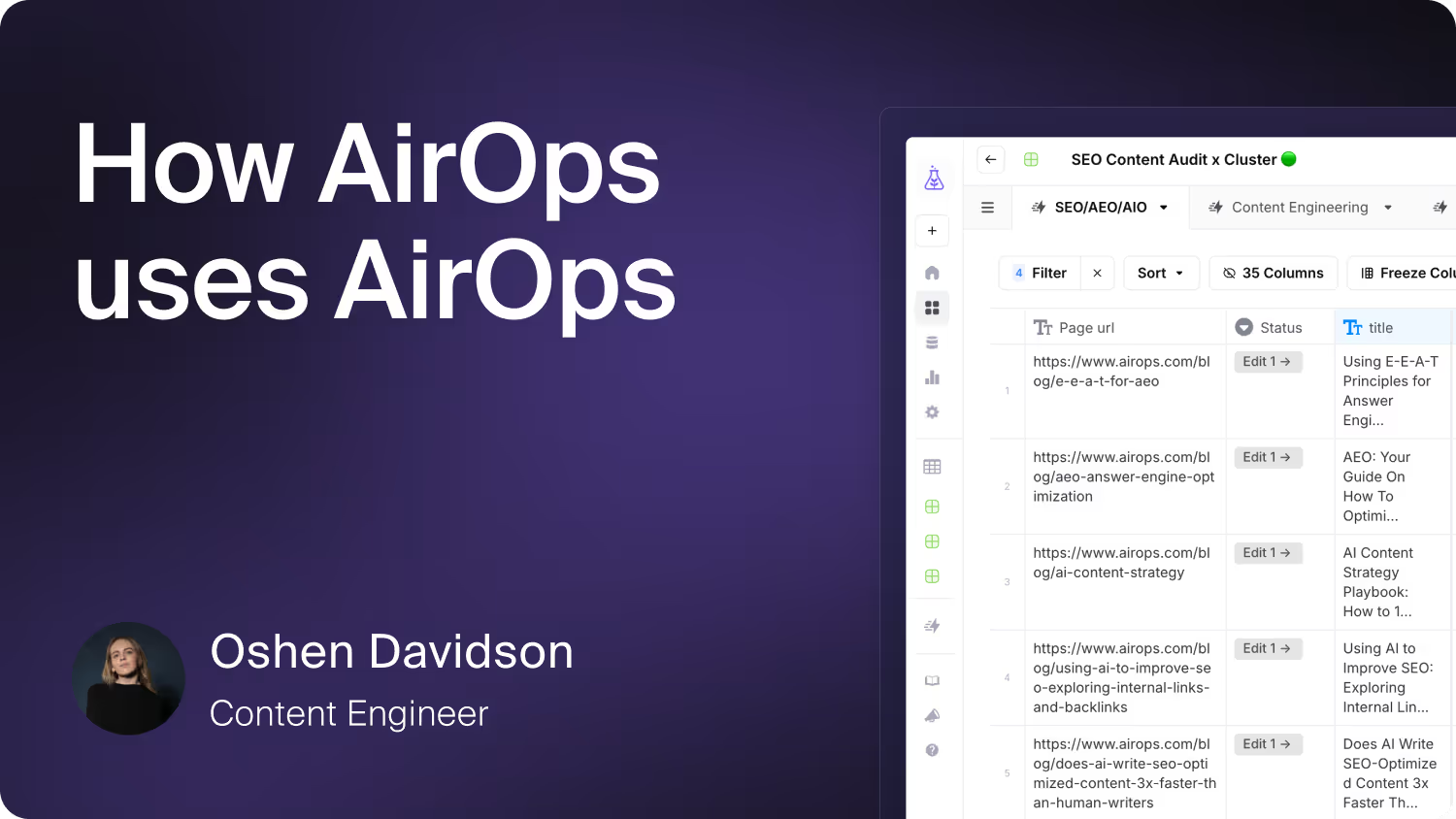How to Make Writing Not AI Detectable

Ever since the release of ChatGPT, AI tools have exploded onto the scene with hundreds of possible options for content creation. While AI writing continues to get better every day, so do search engines and AI detectors.
So, how can you make your AI-generated content undetectable? The key lies in understanding AI-generated content and employing techniques to make it indistinguishable from human writing.
In this guide, we'll discuss what AI-generated content is and provide actionable tips to help you create AI-generated text that bypasses detection while maintaining quality and engagement.
Key Takeaways
- AI writing is detected through algorithms and linguistic analysis identifying patterns typical of machine-generated content.
- Making AI writing undetectable maintains credibility, avoids content filters, enhances user experience, and leverages AI efficiency.
- Refine AI-generated text with human editing, personal anecdotes, and consistent brand voice to add a human touch.
- Incorporate real-world examples, case studies, and specific statistics to differentiate AI content from generic outputs.
- Vary sentence structure and vocabulary to mimic natural human writing and avoid repetitive AI patterns.
- AirOps is an AI tool designed to improve efficiency by combining human creativity and the capabilities of AI to create helpful, engaging, and unique content. Start your journey with AirOps today!
How is AI Writing Detected?
AI writing is detected using various techniques and tools designed to identify patterns and characteristics typical of machine-generated content. One common method involves using algorithms that analyze the text for signs of unnatural language structures, repetitive patterns, and a lack of contextual understanding.
These algorithms compare the suspected AI-generated text against a database of known human and AI-written content to identify similarities.
Another approach uses linguistic analysis to detect inconsistencies in tone, style, and complexity that are often present in AI-generated text. Additionally, some detection tools employ machine learning models trained to recognize specific features of AI writing, such as the frequent use of certain words or phrases, abrupt topic shifts, and non-human-like sentence construction.
Why Make AI Writing Undetectable?
There are two types of consumers using AI tools.
- Individuals who are experts of the niche they are writing in but just want to save time and optimize their processes and increase productivity.
- Individuals that are falsifying experience in a niche and mimicking competitors to seem like experts in the industry.
If you belong to the first category, being flagged for using AI can damage your credibility and raise concerns about the originality and authenticity of your work.
Making your AI-generated writing undetectable offers several benefits:
Maintaining Credibility
Readers value and rely on authentic content for information, especially when that information leads them to a purchase. You can maintain credibility and authority in your niche by ensuring your AI-generated text is indistinguishable from human writing.
Avoiding AI Content Filters
As platforms and search engines develop more sophisticated AI detection tools, content that is flagged as AI-generated may be penalized or removed. Creating undetectable AI content may help you bypass these filters and ensure your content reaches your intended audience.
Enhancing User Experience
Well-crafted AI content provides a seamless user experience. Your readers will engage with your content without questioning its origin, allowing them to focus on the value and insights you provide.
Leveraging AI Efficiency
AI writing tools can significantly reduce the time and effort required to create high-quality content. If you make your AI-generated content undetectable, you can use this efficiency while maintaining the appearance of human-crafted text.
How to Make Writing Not AI Detectable
AI models are trained on vast datasets to generate human-like content. However, they are also trained to be consistent throughout the writing, which ends up being flagged by an AI detector.
Here are the key techniques to make your AI writing undetectable.
1. Refine AI-Generated Text with Human Editing
One effective way to make AI-generated content undetectable is to thoroughly edit and refine the text after creation. While AI writing tools can produce high-quality drafts, they often lack the personal touch and unique perspective that human writers bring to the table.
As you review your AI-generated content, consider adding personal anecdotes or experiences related to the topic at hand. This will help humanize the text and make it more relatable to your readers.
Additionally, it’s important to make sure that the writing style and tone align with your brand voice. AI models are trained on vast datasets encompassing various writing styles, so adapting the generated content to match your own is important.
During the editing process, pay close attention to word choice, sentence structure, and overall flow. Look for opportunities to replace repetitive or generic phrases with more unique and engaging language.
2. Incorporate Specific Examples and Case Studies
Real-world examples, case studies, and personal experiences differentiate your content from generic AI-generated text. AI models excel at providing general information but often struggle to provide specific, relatable examples that resonate with readers.
When crafting your content, think about how you can illustrate your points with concrete examples from your own experience or from well-known case studies in your industry. These real-world references lend credibility to your writing and demonstrate a depth of knowledge that AI models find challenging to replicate.
AI tools like AirOps have given consumers the option to “Bring Your Own Data”. With this feature, you can upload documents, links, website data, and even databases to make sure that the AI content is personalized and caters to your audience.
For instance, if you're writing about successful marketing strategies, you might share a personal anecdote about a campaign you ran that exceeded expectations. Or, you could reference a well-known case study, such as Deepgram, which leveraged AI to grow their organic traffic 20x in 2 months.
When you ground your writing in real-world examples, you make your content more engaging and relatable and differentiate it from AI-generated text that lacks this level of specificity.
Statistics and data points from reputable sources are another powerful way to enhance the authenticity of your writing. When you include relevant statistics, be sure to link to the original source to demonstrate the credibility of your research.
3. Vary Sentence Structure and Vocabulary
As you refine your AI-generated content, pay close attention to sentence structure and vocabulary. AI models may produce text with repetitive patterns or limited word choice, which can be a red flag for AI detectors.
Consciously vary your sentence lengths and structures to create a more natural, human-like flow. Mix short, punchy sentences with longer, more complex ones to maintain reader engagement and mimic the diversity of human writing.
When it comes to vocabulary, challenge yourself to use a wider range of words and phrases.
While AI models have huge knowledge bases, they are programmed to be concise and easy-to-understand. Therefore, these tools often default to the most common or straightforward terms instead of longer and more complex ones. Incorporate unique or specialized vocabulary relevant to your topic to demonstrate a depth of expertise that sets your content apart.
One way to expand your vocabulary is to use a thesaurus or word association tools to find alternatives for overused words. However, be cautious not to overdo it or use words that feel unnatural or forced in the context of your writing.
4. Fact-Check and Correct Inconsistencies
AI writing tools have become incredibly sophisticated but can still generate content with factual inaccuracies or inconsistencies. With technical writing, we’ve noticed AI writers even generating sources and studies that don’t exist.
To ensure your AI-generated writing appears well-researched and credible, you must thoroughly fact-check your content and correct any errors or inconsistencies.
Start by reviewing your content for any claims, statistics, or statements that require verification. Use reputable sources, such as academic journals, government websites, or industry reports, to confirm the accuracy of the information presented.
If you find discrepancies, edit your content to reflect the most current and accurate data.
When citing sources or linking to external resources, ensure that the information you're referencing is up-to-date and relevant to your topic. Broken links or outdated sources can undermine the credibility of your content and make it appear less authoritative to readers and search engine crawlers alike.
As you fact-check your AI-generated content, add additional context or explanations to support your claims. Providing background information or elaborating on complex topics can demonstrate a depth of knowledge that is often unachievable with AI.
5. Maintain a Consistent Writing Style
Maintaining a consistent writing style is key to making your AI-generated content less detectable.
Developing a unique voice and perspective throughout your writing helps differentiate it from generic AI output and drives more sales. A study by Lucidpress found that consistent brand presentation can increase revenue by up to 33%.
To achieve this, you should look for an AI tool that is trained to mimic your brand guidelines. Create a comprehensive style guide that outlines your brand's tone, preferred vocabulary, and formatting conventions. Share this guide with the AI model, to ensure consistency across all pieces.
When working with AI writing tools, take the time to fine-tune the models with your existing content. This trains the AI to better understand and mimic your unique writing style.
Remember, “Garbage in, garbage out” is a term often used with AI. If your inputs are not accurate, descriptive, and reflective of your brand guidelines, the resulting output will not have these elements either.
Remember, the goal is to create content that informs and engages your audience and that is only possible with a consistent brand identity.
6. Use Paraphrasing and Rewriting Techniques
Paraphrasing and rewriting AI-generated content can effectively disguise its origins, making it harder for AI detectors to identify. When you receive output from an AI writing tool, take the time to rephrase sentences, restructure paragraphs, and infuse the text with your unique voice.
While this can be time consuming, it’s one of the best ways to humanize content and remove its “AI feel”.
If you’re looking to speed up the process, there are other AI paraphrasing tools out there which can help you quickly generate alternative versions of your content. These tools use advanced algorithms to rewrite text while maintaining its original meaning, allowing you to create a more distinct piece of writing.
As you paraphrase and rewrite, focus on making the content sound more natural and conversational. Break up long, complex sentences into shorter, more digestible ones. Vary your word choice and sentence structure to create a more engaging reading experience.
Another technique is to combine multiple AI-generated outputs to create a more comprehensive and original piece. Grab key ideas and insights from different sources and weave them together in your own words to create fresh and unique content.
That said, the goal is not simply to disguise AI-generated content but to use it as a starting point for creating high-quality, engaging writing that provides genuine value to your readers.
Does AI Writing Get Traffic and Convert?
AI writing can indeed generate traffic and convert, provided it meets quality and relevance standards. Search engines like Google prioritize content that offers genuine value to users. They are primarily concerned with filtering out spam content created by individuals pretending to be experts as opposed to weeding out AI content.
However, when an expert uses AI to create legitimately helpful content, the scenario changes. AI tools can assist in generating well-researched, informative, and engaging articles that cater to the audience's needs. If the content is accurate, insightful, and provides real value, search engines will not penalize it. Instead, they will recognize the content's usefulness and potentially rank it higher, thereby attracting more traffic. We created a free humanize ai text tool to give you a sample of what's possible.
For conversion, AI writing has a high potential if the content aligns consistently with brand guidelines. Consistent messaging, tone, and style help build trust and credibility with the audience. When users encounter well-crafted AI content that reflects the brand's voice and values, they are more likely to engage with it and take desired actions, such as making a purchase or subscribing to a service.
Final Thoughts
The future of content creation is a blend of AI efficiency and human creativity. As AI writing tools become more sophisticated, distinguishing between AI-generated and human-written content will challenge readers and detection tools.
In this AI boom, AirOps offers a solution for content creators who want to use AI to support their content creation efforts. Our platform is designed to empower you with the tools and insights needed to produce authentic and engaging content.
Whether it’s content ideation, research, or creation, AirOps can help you create the workflows you need to empower your writing team to be more effective and efficient without sacrificing quality.
AirOps recognizes the irreplaceable value of human creativity and oversight. Our human review feature ensures that while AI handles the heavy lifting, the final touch remains distinctly human. This feature allows writers to fine-tune AI-generated content at any stage of the writing process, adding a layer of quality assurance that only human insight can provide.
By blending AI with human editing, AirOps helps you produce content that maintains authenticity and depth, resonating more profoundly with your audience.
Start your journey with AirOps today and unlock AI’s potential to enhance your content strategy, ensuring every piece is impactful and authentic.
Win AI Search.
Increase brand visibility across AI search and Google with the only platform taking you from insights to action.
Get the latest on AI content & marketing
Get the latest in growth and AI workflows delivered to your inbox each week
.avif)





